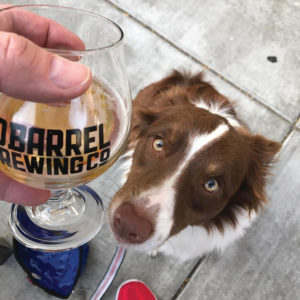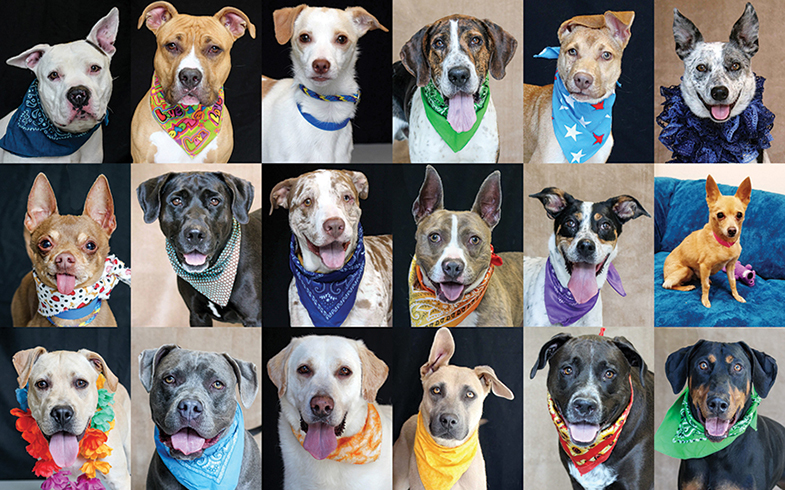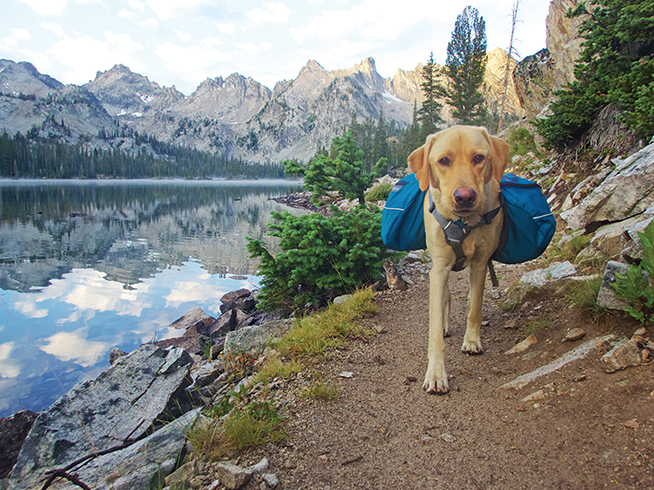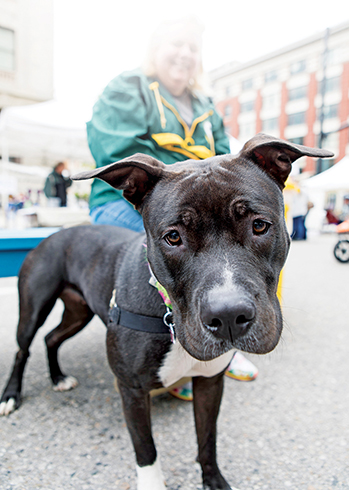If you’re the kind of person who dances with your dog in the living room, makes up songs that feature your favorite hound, and flirts with random pups on the street, Boise is your paradise. If hiking, swimming, and throwing sticks into the Boise River a hundred times for your dog to fetch sounds better than a first-run movie on Netflix, you are in the right place. And if you say “doggo” and “pupper” and “who’s a good boy?” Boiseans will understand.
But it’s not just Boiseans who recognize the dog love-fest coursing through the city. In recent years, Boise has taken its rightful place on WalletHub’s list of Most Pet-Friendly Cities and also showed up on American Veterinary Medical Association’s top 10 list of pet-owning states, with 62 percent of households having at least one four-pawed friend.

Photo: glennsk_instagram
A Dog Walks Into a Bar …
Obviously, the allure of Boise’s sweeping open space, natural amenities and casual lifestyle is as much fun for dog owners as it is for their pooches. This is a city where you and your dog can start your morning with coffee on the patio of a local coffee shop, then take a hike in the foothills, cool off with a dip in the Boise River, enjoy lunch together in downtown Boise, and then grab a beer during “yappy hour” at one of many dog-friendly local breweries, all in one day.
One such dog-friendly brewery is Payette Brewing, which not only welcomes dogs into its taproom every day, it is also home to the popular annual event known as “Dogapalooza,” a celebration of cool dogs and their beer-loving humans. The event, which happens usually in September, features outdoor kiddie pools for the dogs to cool off in, dog treats, a canine costume contest and of course beer, conversation and potential new meet-ups, both for dogs and their humans.
The notion of treating dogs like part of the family is prevalent throughout the city. A recent dinner at Highlands Hollow Brewhouse showed the Boise dog culture in full swing as at least three tables on the outdoor patio had canine companions sprawled quietly underneath their chairs as water misters cooled the summer heat. Occasionally the dogs would get up to wander around, looking for a scratch on the head, which diners gladly provided. In view behind the restaurant, hikers and dogs trotted down the foothills trails and then headed onto the patio for some shade and something cold to drink.
It was a pretty typical scene for Boise.
Giving Dogs Their Space
It’s not unusual to go to one of the many dog-friendly parks and see a group of people standing together socializing and sipping coffee while their dogs romp and wrestle like kids at a playground. Boise dog parks can be a social event, where people learn the names of all the dogs they see on a regular basis but may not even know the owners’ names.
However, up until the late 1990s, Boise had no designated off-leash areas for people to take their dogs. Then, in about 1998, the city’s Parks and Recreation Department began working with dog owners in the community to plan and design a dedicated dog open space.
Erik Kingston, a member of City DOG (Dog Owners Group) in the late 1990s, said that when the discussions started, “One hundred percent of Boise’s developed parkland was off-limits to off-leash dogs, except for the flood basin at Military Reserve and a site in southeast Boise.” He said that the city and community members went through two years of monthly meetings, and in 2000 the Parks and Recreation Commission designated the Military Reserve basin as a permanent off-leash area. “Even though its primary purpose is still flood control, dogs and owners still love its wide-open, low-maintenance running space,” said Kingston.
Since then, the city has worked to welcome dogs into more public spaces and has added three more designated off-leash areas and nine other parks where dogs can romp within certain hours and seasons. (See sidebar for list of parks and restrictions).
While Boise doesn’t have the most dog parks in the nation, it does lead the pack with the highest number of dog parks per capita: 6.7 dog parks per 100,000 residents, edging out the second-place cities of Portland, Ore. and Henderson, Nev.
“Boise is awash in parks and trails for people, and I think dogs have it pretty good here in our fair city, too,” said Boise City Council President Lauren McLean. “As the Trust for Public Lands pointed out in their 2018 ParkScore Index, Boise has the highest number of dog parks per 100,000 residents. Dogs in Boise can run in the foothills, cool off in the river, and play in dog parks throughout the city.”
Perhaps one of the biggest “dog parks” in all of Boise is the expansive open space and trail system in the surrounding Boise foothills. Most of the foothills trails surrounding Boise are controlled off-leash, enabling dogs and their people to recreate together in some of the most scenic surroundings in the country. Of course, along with the benefits come certain rules. For instance, owners must keep a leash with them at all times, and dogs need to be under voice control and stay within 30 feet of their owners. Off-leash etiquette also forbids dogs from chasing wildlife, digging up the land, and fighting with other dogs or trail users. And, it is expected that owners will always pick up after their dogs.

Photo courtesy Idaho Humane Society
Saving Boise’s Dogs
As much as Boise loves its animals, there are still plenty of dogs that are begging to be adopted. Fortunately, there are several legitimate local organizations that gladly accept rescues, wanderers and the unwanted, and give hopeful future dog parents a variety of canine companions from which to choose. The most well-known of these, the Idaho Humane Society (IHS), is an “open admission” shelter, meaning it doesn’t turn any animal away for age, injury, or lack of space. Annually IHS takes in 10,749 animals and adopts out 6,435, fosters 1,385, and reunites 1,690 pets with their owners. The IHS also partners with Dog Is My Co-Pilot, a volunteer flight operation where private pilots fly animals from overcrowded, high-kill shelters in another state to shelters like the IHS that maintain a no-kill philosophy. Last year, 1,592 animals were transferred into the IHS from other shelters.
Other adoption organizations around the Boise area include the West Valley Animal Shelter in Canyon County, and Boise Bully Breed Rescue.
The heart that keeps these organizations beating is the dedication of Boiseans who volunteer their time to help the many lost and unwanted animals. Melanie Larson, director of volunteer services at the Idaho Humane Society, said that more than 1,400 volunteers and foster parents support the work of IHS. Every month over 300 volunteers donate more than 2,500 hours of their time, walking dogs, petting cats, wrangling dogs at mobile adoption sites, and helping wherever needed.
Boiseans are fierce when it comes to finding and reuniting lost pets. A Facebook page called “Treasure Valley missing/found/spotted pets!” posts photos and locations of wandering dogs and cats. The group coordinates and cross-posts with shelters, Craigslist, law enforcement, and Nextdoor neighborhood websites. Its success rate is high.
What Kind of Dog Is That?
According to a 2017 TIME Magazine survey, the most popular purebred dogs in Idaho are Labrador and golden retrievers, and German shepherds. But a quick look around town will reveal that the most popular big dogs are the all-American mutt, with lots of Australian shepherd mashups, pit bull mixes, and variations on heelers, doodles and border collies. Pubs and cafe patios reveal an abundance of smaller mutts with bloodlines from beagles and dachshunds, miniature poodles and Chihuahuas.
Breed-specific and activity-specific dog groups thrive in Boise. Gathering on Facebook, the “Stubby Strutters” is for fans of Welsh corgis and corgi mixes. Another, “Boise Hiking With Dogs,” organizes frequent outings and offers classes in trail etiquette. “Boise Agility Runners and Climbers (BARC),” a group promoting dog agility training, practice, and competitions, has members who have handled their dogs to championship status, and competed to win in local, regional, and national events.
Heart of the West
Wild Idaho was discovered and tamed in the 1800s with the help of loyal working dogs. In fact, the journals of Idaho explorers Lewis and Clark reveal that hunting and guard dogs were important members of their expedition party. Since then, generations of Boiseans have grown up in rural Idaho areas where working dogs—cattle herders and heelers like border collies and corgis; livestock guardian breeds like Great Pyrenees and Anatolian shepherds, and hunting dogs like Labradors and setters—are the usual. Perhaps, even today, that’s partly why these breeds seem to be in such abundance in Boise.
Joan McCarter, who grew up in Corral—a place so small that most Idahoans have never heard of it—but now lives in Boise (with her two dogs) said, “My first clear memory is using Toby, our German shepherd/Russian wolfhound to prop myself up early in my walking career. I can still feel his fur. He was huge and could run like the wind. So I guess I learned to walk with the help of a dog. I also learned that a good cattle dog could be a lot better than any hired hand, or kid. Dad usually preferred to take the blue heeler, Sam, to move cattle around on our Forest Service reserve rather than one of us kids.”
Today, dogs still work the Idaho ranches and farms; herd cattle, guard sheep and accompany ranchers in the vast open rangeland. But for many Boiseans, they are simply family members who tag along as part of everyday life—to the park, the river, the mountains, downtown, on vacation.
Perhaps Boise’s sense of puppy love can be summed up in the words of composer, singer and longtime Idaho resident Carole King, who once said, “When I wake up every morning, I smile and say, ‘Thank you.’ Because out of my window I can see the mountains, then go hiking with my dog and share her bounding joy in the world.”


